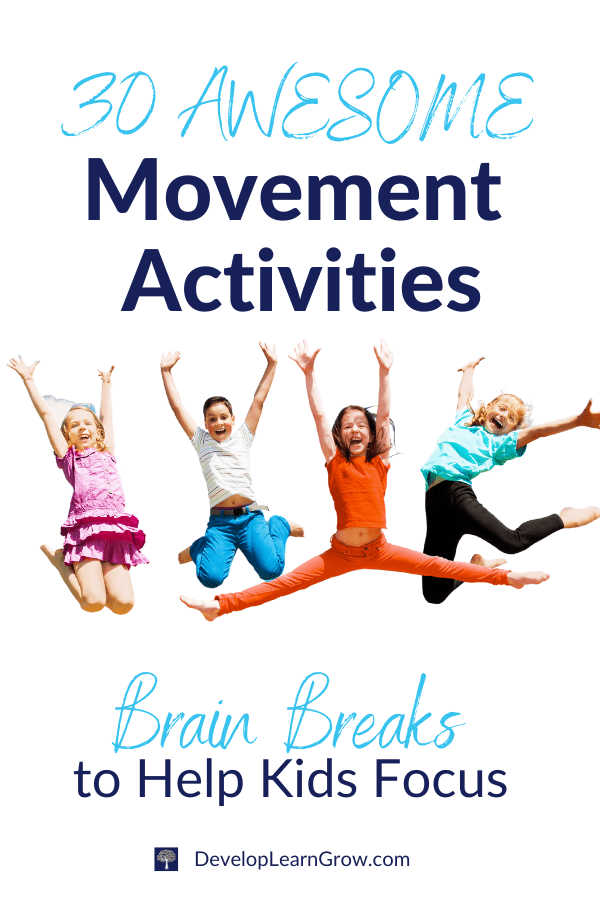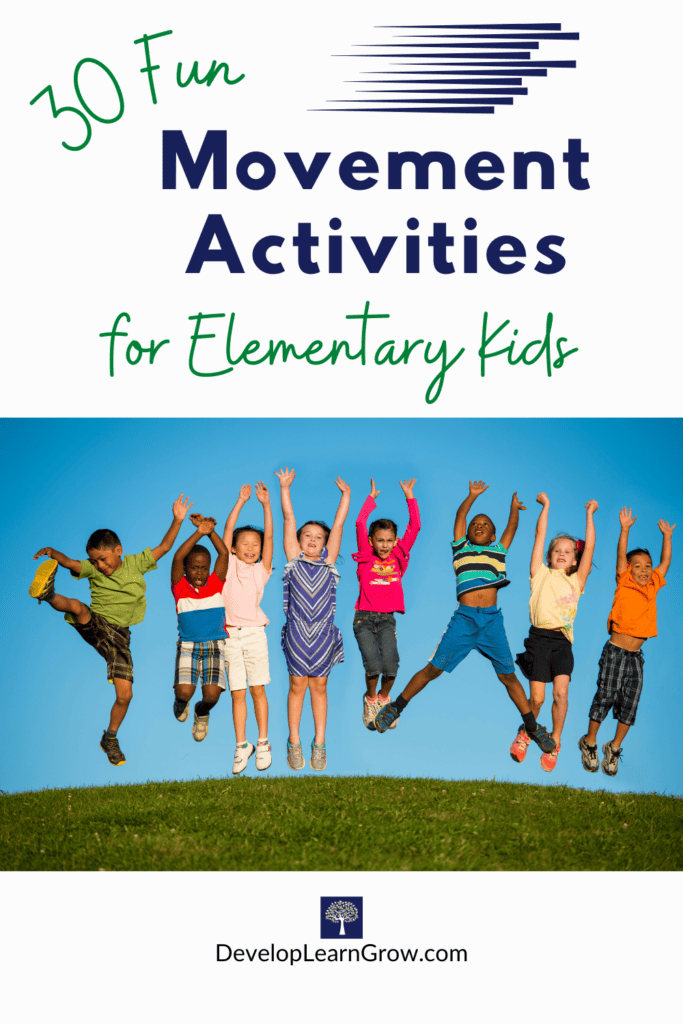Incorporating movement activities into your elementary kids’ daily routines is a great way to enhance learning. Young children (and older kids) need movement brain breaks and gross motor activities to improve their ability to focus. There are different ways to embed movement games and activities into daily learning tasks – in the classroom or during homeschooling.
What Part of the Brain do Movement Activities Stimulate?
Movement activities stimulate the vestibular system in the brain. The vestibular system is one of the most important sensory systems that serves as the foundation for learning (click to check out the sensory pyramid of learning.)
It is the director of the nervous system. The conductor. It’s in charge and it guides ALL the other sensory systems in the brain.
The vestibular system gives us movement and balance information. Receptors deep in the inner ear detect movement. Fluid stimulates small hairs inside semi-circular canals as we move.
When children process movement well, they move smoothly and efficiently. Their bodies feel safe and secure. They’re able to move around and maintain balance positions without falling.
Movement input for young and older kids supports physical development, gross motor skills, and fine motor skills.
The movement / balance centers in the brain also help support visual development and hand-eye coordination.
Movement sensory input can be given in various directions and at various speeds. It can be provided through outdoor play, an indoor obstacle course, or simple movement breaks during the school day.
The movement system can also be stimulated through simple balance activities. Movement is an easy way to support overall development and cognitive skills.
Even more, regular physical activity supports emotional well being – which is so important for kids now!
The program Fluency and Fitness has videos that incorporates reading and math into their movement exercises.
Why are Movement Activities Important for Elementary Students When Learning?
Kids NEED to move! Gross motor and movement activities provide foundational sensory input for children. Vestibular and movement input is important for child development.
Babies, toddlers, preschoolers, school-age students and teenagers all need movement. It’s been a routine part of my occupational therapy sessions when working with children.
Vestibular input through movement or balancing wakes up the brain and provides so much fun for kids at school!
Movement input is a great way to stimulate the nervous system to help your students. It’s a powerful way to improve attention for learning. Movement increases blood flow in the body and brain.
Many kids spend more time indoors than they used to. Sedentary play has increased. Screen use has sadly increased.
The pandemic caused many kids to decrease regular physical activity and outdoor play. Kids are having a really hard time remaining engaged in daily tasks. Their bodies are not meant to be still for long periods of time.
All of these factors makes it even more necessary for you as an educator to incorporate movement brain breaks into learning routines. You can also encourage parents to do the same with your students at home during play activities.
Benefits of movement in young children and older kids:
- Organizes the nervous system
- Increases alertness and the ability to focus
- Gives info on position in space
- Improves muscle tone (especially core strength and postural stability)
- Increases bone density
- Supports gross motor skills and physical development
- Contributes to fine motor skills
- Improves control of the eye muscles (see Visual Skills for Reading post)
- Enhances emotional well being
- Improves social interaction
- Makes learning fun!

Movement Activities and Movement Games – Enhance Learning in Young Children
Movement games and activities are a great way to improve attention and focus for learning in young children. The fun activities listed below are organized by space and location to make it easier for you to plug them into your school day! They’re also great for a rainy day or indoor recess.
When kids are sitting at a desk or table area, perform these easy indoor movement activities as quick brain breaks. Pick a movement exercise and make it a fun game for kids during learning. They can perform the balance or movement activity as they count, spell, repeat a fact, work on math skills, etc:
- Stand on each leg
- Spin around
- Windmills
- Toe touches
- Jump in place
- Squat to the floor and jump up quickly
- Hop on one foot
- Yoga tree pose
- Jumping jacks
- March in place
- Jog in place
- Dance to fun music or a beat or rhythm
Movement games and gross motor activities to practice around the entire classroom:
- Scavenger hunt games (to find and copy math problems, sight words, rhyming words, definitions, etc)
- March back and forth or around the perimeter of the room
- Create a taped area for a balance beam – walk back and forth to match learning activities (rhyming words, math problems / answers, sight words, etc)
- Toe walk around the room or on the taped balance beam
- Create a pacing lane for students to walk back and forth in while reading or listening
- Use balance spotters to walk, jump or hop on (on the way out the door to the bathroom or back and forth for a learning activity)
- Balance boards
- Animal walks (duck, bear, crab, elephant, inchworm)
Activities that offer a lot of movement, in the hallway or in a large open room:
- Cartwheels
- Somersaults
- Log rolls
- Relay races
- Hopscotch
- Scooter board activities
- Jump rope
- Hip-hop balls with handles
- Obstacle courses
- Spinning games

Additional Tips for Incorporating Simple Movement Activities in Your Classroom
When working in the schools, I’ve made some tools for teachers to help incorporate movement brain breaks. Teachers have also created their own home-made tools. Making it more of a fun game makes it more engaging for the students.
Pick your favorite movement exercises and write them:
- On popsicle sticks in a cup / mug
- On a large beach ball – toss it to a student, when the student catches the ball, they choose the exercise “closest to their right thumb”
- Onto an empty tissue box covered with paper – roll like dice, or toss to catch and choose the… “exercise facing you”
- On cards – place holes in the corner and place on a ring to hang somewhere in the room
- On a numbered list in the front of the room (to use with dice or a single die)
- Roll a small die to match the number of the exercise on the list
- Make a large die out of an empty tissue box with dots on it
- On a large pinwheel with an arrow (to spin with the arrow pointing to the exercises)
- Use poster board to make a circle
- Punch a small hole in the center
- Cut out an arrow and attach to the center with a fastener, spin the arrow
- Or, stabilize the back of the fastener to another layer of poster board the wall and spin the large circle
- Using a wheel of names app and adding the exercises to the spinning wheel. You can add as many as you like!
For a specialized brain break exercise program, check out:
Use these specific occupational therapy exercises to improve:
Attention… focus… core stability… crossing midline… sensory processing… visual development… & more… Click for more info!
Additional Considerations with Movement Activities
Make sure your students have core exercises embedded into their day. Kids need strong cores in order to move effectively. Check out 40 Fun Core Exercises for Kids.
Most children process movement input well if given the appropriate opportunities during infancy, toddlerhood and into preschool. They need daily movement experiences to help with balance to improve visual skills for learning.
You may come across kids who have difficulty with balancing tasks. But, with time and practice… they improve. Overall, they can go about their daily routines without difficulty.
You may have a group of kiddos – small or large… depending on your year 😉 – who really need the movement to help them focus.
In addition to frequent gross motor brain breaks, recess is a great time to encourage movement (and to work on social skills.) Be sure that you don’t withhold recess for kids who are misbehaving at school. Oftentimes, they’re the students who NEED RECESS THE MOST so that they can behave better!
For these kids who need more movement than you can plug into your routines, meet with your team and find safe ways to add more intense movement during the day. I knew of a student who frequently took breaks from the classroom. Her principal, teacher and parents allowed her to do cartwheels in the empty hallway when she needed the extra input to focus!
It helped her to tremendously throughout her third grade year!
On the other hand, some kiddos can be a little sensitive to movement. A sensitive child can become overstimulated from spinning or upside down motions. However, they’re more likely to become overexcited with too much time on a tire swing or a merry-go-round, not these simple activities.
You’ll likely be notified by parents or administrators if a specific child has these sensory processing challenges. If so, you may want to keep an eye on them. Or consult with your school’s occupational therapist.
For More Information on Movement Activities for Elementary Kids:
Gross Motor Outdoor Games for Kids at School – Add some fun skill building gross motor activities during recess.
Flexible Seating in the Classroom – Check out these cool seating options that give movement input.
For a FREE printable, check out: Best Brain Break Exercises – Use a specific exercise sequence to activate all parts of the brain for learning or before a test! Brain Gym Exercises are included in this series.
Free Printable: 25 Brain Breaks for Kids: Improve Focus and Attention – Use proprioceptive input to organize the brain and prep a child for learning activities or tests.
Leave a comment below to share your favorite movement break with kids.




0 Comments